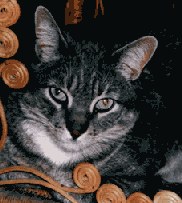|
Brendan Takes His Medicine
In late September, 1998, I noticed a dramatic change in Brendan's behavior. Though this 11
year-old cat had always been very fond of water, preferring to drink it out of the
filtering device by the sink, one day he jumped up to the counter for drinks at least a
dozen times—and the results of his excess were soon evident in the litter box. I
waited a week to be sure that this wasn't a passing feline aberration; then made an
appointment with the vet. change in Brendan's behavior. Though this 11
year-old cat had always been very fond of water, preferring to drink it out of the
filtering device by the sink, one day he jumped up to the counter for drinks at least a
dozen times—and the results of his excess were soon evident in the litter box. I
waited a week to be sure that this wasn't a passing feline aberration; then made an
appointment with the vet.
His glucose levels were 478. Even allowing for stress (this is a cat who does not travel
well), there was strong reason to suspect diabetes. A urine test confirmed this. The vet
was prepared to put him on insulin right away, but I'd done considerable research on the
Internet and had heard about oral medication for cats with diabetes. He was dubious, but
called me back the next day to say that his own research yielded the information that cats
who were overweight (we don't say obese) had a 20% success rate with glipizide, and might
become diabetes-free if they lost sufficient weight.
Brendan began with 5 mg of glipizide once a day immediately. Fortunately, he was
good-natured about taking the pill, but he was less amiable about being deprived of the
wet food he loved. It took several days of pouring the oil from tuna fish cans over his
Science Diet Feline Light dry food before he resigned himself to the dietary change.
At his next visit a month later his glucose level dropped to 278, and he lost a pound. The
next month the vet ran a fructosamine test which showed that his glucose levels were still
higher than they should have been. His medication was increased to two 5 mg tablets of
glipizide per day.
In January I was still not satisfied with the litter box results, and researched dry cat
foods. I decided to try Purina OM, and his drinking and urinating decreased substantially
after a few days.
At his most recent visit his glucose levels were within normal range, and he weighed two
pounds less than he had at his initial visit.
There have been other positive changes. He became interested in eating nutritional yeast,
and his coat, which at the onset of diabetes, had been rough and matted, became more silky
than it ever had been.
During his first few months of being diabetic he had lost a great deal of strength in his
hind legs, and had become unable to jump up onto the counter for his water fix. Now he
gallops up the stairs, and leaps onto the counter like a feline Olympic champion.
I feel that the oral medication route should always be considered for overweight cats who
are otherwise healthy and are not showing severe signs of diabetes. It does, however,
require patience. It was several months before Brendan's glucose levels fell to an
acceptable level.
In his case dietary changes made a huge difference in getting him
stabilized. I chose
Purina OM, but the Pet Diabetes web site has a chart with nutritional comparisons among a
number of dry foods. Nutritional yeast, which has a number of trace minerals which can
help ease diabetes, also makes dry food more palatable. Most cats love it.
Today Brendan is slimmer, sleeker, and more active than he was a year ago. Ironically, his
overall treatment for diabetes has turned him into a healthier cat.
Contributed by Connie
In January, 2000 Brendan went to the Rainbow Bridge after contracting
feline infectious peritonitis.
Read educational information about glipizide and other
oral diabetes medications.
  



Contributed September 1999
Copyright. All rights reserved.
This site is for information purposes only. Please consult
your veterinarian. |
 A
Successful Glipizide Experience
A
Successful Glipizide Experience A
Successful Glipizide Experience
A
Successful Glipizide Experience